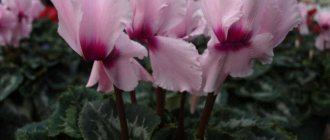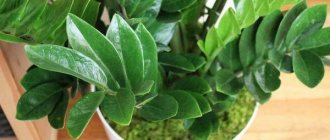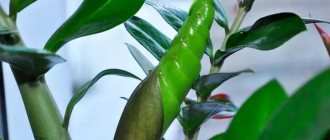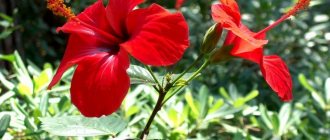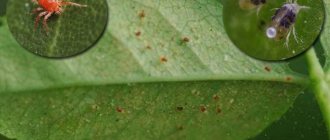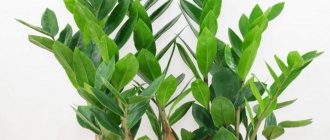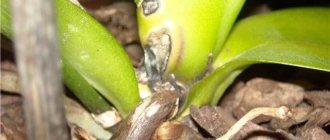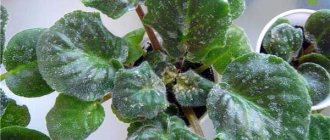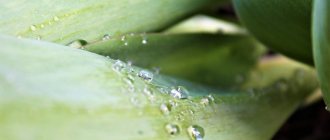This decorative flower comes from Africa. On its meter-long leaves-stems there are paired dark green leaves that are leathery to the touch. With proper care, the flower has enviable immunity and therefore rarely gets sick. But in people who do not have experience in cultivating plants, it can hurt:
Dear readers! For you, we have created communities on social networks in which useful articles and interesting ideas are published several times a day! Subscribe and receive useful content in a convenient format!
- Viral diseases;
- Microbial diseases;
- Damaged by pests.
Zamioculcas is not a whimsical plant, and the main thing for the gardener is not to harm it with excessive attention.
What diseases affect Dollar Tree?
Sometimes with a newly brought flower you can introduce a fungal disease into your collection. Experienced flower growers recommend quarantining newcomers for 2 weeks, and then it will be clear whether he is infected or not.
Anthracnose
A fungal disease that attacks the leaves and stems of a plant.
Black and brown spots appear on them and grow over time. Most often, this fungus appears in greenhouse conditions , when the room is warm and humid.
This disease is not difficult to survive cold weather and therefore, in order to completely get rid of it, the plant must be treated with fungicides:
- Bordeaux mixture;
- Colloidal sulfur;
- Copper kuparos.
Powdery mildew
Powdery mildew appears in the warm season plus increased watering.
It is easy to notice by the coating on the plant, it looks like flour.
When the disease occurs, the affected leaf blades become covered with a powdery coating and die off after a while. Therefore, treatment begins with:
- Topaz;
- Speed
Sooty (black) fungi
The manifestation of the disease is a sooty black coating on the plant. Appears due to the sticky secretions of such pests:
- Aphid;
- Whitefly;
- Mealybug.
First of all, you need to get rid of harmful insects, and only then get rid of the sooty fungus itself. Zamioculcas can be washed with laundry soap after treatment. If this does not help, then treat with phytosporin.
Leaf burns
Burns to leaf blades cannot be treated.
The affected leaf remains damaged.
It’s just that in the summer, when the sun’s rays behave noticeably more aggressively, the zamioculcas is removed from the south window and moved to the north window, or if there is none, then deeper into the room.
Rotten
To get rid of rotting places on a flower, you need to remove it from the soil, get rid of all affected areas and treat it with appropriate fungicides. The pot is doused with boiling water, and new soil is purchased. When cultivating this flower further, you must carefully monitor its watering and not overwater it.
Important! You need to periodically inspect your pets for pests, otherwise the plant may not be saved. Therefore, in the initial stage, the lesion is easier to treat than when the entire flower is completely affected.
Diseases
Sometimes situations arise when zamioculcas, growing at home, dries out, turns yellow, stops growing or dies altogether. A common cause of the above phenomena is plant disease.
Trunk
When the stem rots and dark black or brown spots appear on it, it can be said that the flower is diseased. At the same time, in addition to the above symptoms, the plant is often attacked by root rot. The reason for this condition is often hidden in excessive irrigation, low room temperature, and improperly prepared substrate . With high heaviness and clay content of the soil, as well as lack of drainage, water stagnation occurs, which entails rotting processes.
The first thing to do in this situation is to normalize environmental conditions, that is, temperature and watering. It is also recommended to remove the flower from the pot and carry out health procedures. Each part of the “dollar tree” must be treated with a fungicidal solution, transplanted into a new container or disinfected the old one. In a situation of excessive damage, plants utilize the flower.
Tuber
If watering the dollar tree is not organized correctly, this can lead to problems with the tubers. Drying of the root system indicates a prolonged lack of watering. Despite the ability of flower tubers to accumulate liquid, do not forget about organized irrigation of the plant.
In a situation where Zamioculcas has rotted, we can talk about its bay. The flower will urgently need measures such as replanting and eliminating all rotten elements. In this case, it is worth using a purchased substrate - desert soil for cacti would be an ideal option. If the dollar tree tuber has not rotted, but only turned black, then this indicates an old root system. The appearance of white roots means that the plant is producing new, young and strong tubers.
Problems with Zamioculcas leaves
Sometimes, due to improper maintenance, various diseases appear. The trunk darkens in spots or the leaf blades turn yellow. This is a consequence of two main mistakes: the gardener dries out his flower, using too infrequent watering, or the flower is flooded, often using too cold water.
Turn yellow
If this slight yellowing is not more than 5% of the total leaf mass, then this is natural aging of the leaves.
It’s worse if the entire meter-long branch turns yellow at once. This indicates improper care or pest infestation. Therefore, it is necessary to reconsider the irrigation regime and water quality.
If everything is in order, the flower is inspected for the presence of pests and if they are found, they immediately begin to treat it with the necessary drugs.
Wither
Leaf blades can wither due to natural aging, and this only happens to the lower leaf blades.
If the entire branch dries out, then this is mechanical damage or errors in the watering and lighting modes.
If this occurs with the simultaneous appearance of black spots, then this is a sure sign of root rotting from overwatering the plant and watering with cold water.
Important! Follow watering rules.
Stains
Dark spots are a manifestation of improper care due to excessive watering of the plant. Leaf blades with black spots are removed, the plant is pulled out of the ground and the root system is examined. If rotting places are found on it, then they are cut out to healthy flesh, treated with wood ash and the zamioculcas is planted in new soil. In this case, it is worth reducing the frequency of watering.- Brown blotches on the leaves appear in the cold season from being kept in a place where there are cold drafts. To prevent new blots from appearing, the flower is moved to a warm place without drafts.
- Black spots on the stems are a consequence of overwatering or indicate that some of the roots have died. It is necessary to organize proper care for Zamioculcas.
Sticky spots on leaves
Sticky leaf plates appear at the moment when the flower is affected by harmful insects. Since stickiness is a product of their vital activity. Feeding on the sap of the plant, they secrete a sticky mass, and sooty fungus often appears, since its spores easily stick to such foliage.
Important! Therefore, when such leaf plates are detected, it is necessary to urgently find the pest and begin treating the flower.
The trunk is darkening
Why
To answer the question “why is it darkening” and “what to do”, you need to determine the nature of the darkening of the stem.
- Dark spots appeared on the trunk. Pay attention to the condition of the plant. If there are no wet spots, rot, or pests, then everything is fine with your flower.
As with yellowing, when the trunk darkens it is important to determine the source of the problems
This is the decorative feature of Zamioculcas. You can see on its stem not only various spots, but also dark stripes. This does not mean that the plant is suffering.
- If the stem darkens from the root , most likely your pet has fallen ill. This phenomenon leads to trunk rot and death. The most common cause is overwatering or low temperature.
If the room is cold, the soil does not dry out well. As a result, it leads to stagnation of water in the pot and rotting of the roots and tubers of the flower.
What to do
First of all, it is necessary to normalize the conditions of detention. Adjust watering. Zamioculcas will have to be transplanted into a new pot with fresh soil.
If you couldn't save it, cut off the top . Having rooted it, you will get a new young plant.
Problems with roots
If the watering regime is improperly organized, Zamioculcas may experience problems with the root mass.
Drying
If the root system of a plant that is adapted to live in the desert dries out, this means that the grower has not watered the plant for six months. Because the root system of Zamioculcas is capable of accumulating in its potatoes the water necessary to nourish its own bush. Therefore, it is necessary to organize a watering regime. If the roots die immediately, they can be grown again.
Rotting
This is the same bay of the plant.
He urgently needs a transplant with the simultaneous removal of all rotting parts. In this case, the land must be purchased, since garden soil is too rich for this flower.
Land for desert cacti will suit him. After processing and planting in new soil, watering begins 15 days later. In this case, the water should be warm and settled. Zamioculcas fertilization begins a month after planting.
Black
If these are not rotting roots, since the watering regime was followed, then most likely these are just adult (old) roots of Zamioculcas. If they have white growing tips, then these are healthy roots.
Spots on the roots
Spots on the root system indicate that the flower is given too frequent watering. In this case, cold water is used. To correct this situation, water with warm water and at least 2 times less often than the previous regime.
Possible causes of plant death
In order for the exotic Zamioculcas to grow normally and delight gardeners with its appearance, you need to put in very little effort. But if you want this plant to live indoors, you should give it due attention. If signs of disease appear, they should be eliminated immediately. A flower can die if it freezes or is flooded with water.
If the dollar tree is frozen, then it is worth saving its roots. The part of the plant that has already died should be cut off. The Zircon solution can help in this case, as it promotes rapid adaptation of the flower and the elimination of a stressful state. After the procedures described above, zamioculcas recovers on its own and produces new foliage.
In a situation where the flower is over-watered, there is no need to wait for the moisture to evaporate. The root system of a houseplant rots very quickly when flooded with water, so it should be immediately transplanted into a new pot.
Pests on the roots
Harmful insects come either from contaminated soil or brought from the store with another purchased flower. Therefore, the new recruit is usually quarantined 2 weeks away from the main array of flowers in the house.
If a pest is found on yellowing foliage, the flower is removed further from other plants and treatment begins.
Important! If a pest is noticed in time, you can get rid of it quite quickly, so it is recommended to inspect the flower from time to time for their presence.
Mealybug
Leaf plates can become deformed due to the appearance of mealybugs on them.
This harmful insect lives and breeds on the leaves of Zamioculcas. It is easy to detect because it secretes a sticky white cotton wool as it feeds on the sap of the plant.
Its harmful effect on the plant is not only that they feed on its sap, but also its secretions on the leaf blades block the access of oxygen and the affected leaves do not participate in photosynthesis.
To get rid of scale insects, wash the flower with 72% laundry soap, and if this does not help, treat it with one of these preparations, diluting them according to the instructions indicated on the package:
- Aktellik;
- Phytoyerm;
- Intavir.
Thrips
The fact that thrips have appeared on the plant will be indicated by a white coating on the leaves and twisted shoots.
The flower must be placed at a safe distance from other indoor plants and its treatment must be started using the following preparations:
- Karbafos;
- Intavir.
Important! When processing plants, you must adhere to safety rules so as not to cause poisoning to children and pets.
Ticks
This pest is easy to detect on the green mass of the plant - it is small, up to 1 mm long. a red spider that forms a web on the outside of the leaf blade.
It is removed mechanically by wiping the leaf plates with a cotton swab soaked in alcohol.
In hard-to-reach places, use an ear stick to remove cobwebs. Then they are treated with Aktara or Aktellik. The action must be repeated twice with an interval of 5-6 days. This is the time during which the tick larvae begin to hatch from the eggs.
If it is not possible to treat chemically, then you can use a folk remedy and treat the plant bush with green soap purchased at the pharmacy. The treatment is carried out until the pest disappears.
Shields
This pest is easy to see on the leaves of the flower as it reaches a length of up to 4 mm.
and it is brown in color. The shell is easily removed with a fingernail, but underneath there are many larvae that feed on the sap of the plant. And then black spots appear on the leaves and they dry out.
Before processing a plant, you must first remove all shells mechanically and then proceed to chemical processing. The shells are removed manually, since the chemicals do not fully penetrate under them, and the surviving larvae will build a new shell for themselves and begin to reproduce again. Preparations that can rid a flower of this pest:
- Actellik - it is treated three times with an interval of 6-7 days.
How to reanimate Zamioculcas?
What if the plant's tuber rots?
In this case, we take out everything that is left of the flower and clean it to a healthy place. From the remains we grow a new flower. If there is at least some root growth, we plant it immediately in new soil; if there are only leaves left, we put them in water to grow roots.
If the leaves curl?
Deformation of the leaves indicates that the flower is affected by harmful insects. In this case, the zamioculcas must be carefully examined and, having found them, get rid of the pests with a suitable preparation.
What if the leaves of the plant are frostbitten during transportation?
This is the easiest case of what can happen to Zamioculcas. Since the root system in this case is completely healthy, the frostbitten leaves are cut off at the root, and after a while the roots begin to produce new healthy leaves.
Care Tips
In order for Zamioculcas to please its owners with its beauty, it is worth paying due attention to it and adhering to the appropriate rules of care. After finishing treating the plant with insecticides, it is worth protecting the soil by covering it with film. After a day, when the chemicals are washed off with water, the flower must be protected from their penetration to the root. To do this, the substrate is re-covered.
The main thing that should not be forgotten is that the “dollar tree” is a representative of the flora that is resistant to infectious diseases, but only under the condition of absolute health. An exotic flower should be provided with fluid drainage and the correct temperature and lighting conditions.
In summer, Zamioculcas should be taken outside, this will make it stronger and more beautiful.
The following video will tell you how to treat zamioculcas.
What to do if the leaves of Zamioculcas turn yellow and the trunk turns black? The reasons may be natural or arise from errors in the care process. Despite the fact that the plant is fairly easy to care for, growing it indoors is not always easy. Let's see what to do in such a situation.
Fungicides for Zamioculcas
Zamioculcas can be treated with the following drugs:
- Maxim - helps with red burns and various manifestations of rot;
- Fitosporin against fungi at the initial stage of infection;
- Fundazol – it kills various fungal spores;
- Hom – helps against brown spot and various bacterial diseases;
- Quinozol is an antibacterial chemical;
From a variety of drugs, only one is selected and the plant is treated with it according to the instructions.
Common mistakes
With improper care, errors occur, and in order for the plant not to die, you must try to correct them in time.
| Care error | Correction method |
| Reduced room temperature and simultaneous flooding of plants | If there are young shoots, then you don’t have to worry, just move them to a warm room and adjust the watering. If the flower does not grow, then it is removed from the soil and the roots are treated from rotting places. |
| High air humidity. | Droplets of water appear along the edges of the leaves; the plant seems to be crying. All aroids react this way to a prolonged rainy period; you don’t have to do anything special. |
| Pot too big. | The plant does not increase its green mass, since it needs to reduce the container in which it grows. |
Dark spots
One of the most common among them is dark spots on the tree trunk. They can be caused by a variety of reasons; accordingly, methods of treatment and prevention also vary.
Causes
Large spots often occur when the temperature of Zamioculcas cultivation is too cold.
- Feature of the flower . If dark spots appear on a flower, but this process is not accompanied by rotting, it is likely that we are talking about the individual characteristics of the plant.
- If there are at least 15 adult yellowed leaves , and there are new shoots nearby, there is no particular reason to worry. This can often be observed if the plant goes through a stage of rejuvenation. In this case, it is enough just to remove the leaves after they are completely dry.
- If traces of rot are detected, certain measures should be taken, as this indicates the presence of some kind of disease . The first thing to do is treat the plant trunk with any antiseptic. In addition, if necessary, the soil can be replaced.
Answers to frequently asked questions
Why do Zamioculcas leaves turn yellow and fall off in winter?
When it gets very cold indoors, the flower begins to turn yellow its leaves. If this does not happen en masse, then there is nothing to worry about. If the central heating radiators make the house too hot and dry, then you need to spray the flower with a spray bottle.
Why do the plant's stems lie horizontal to the ground?
This comes from overwatering. The plant is oversaturated with moisture and the stems bend under its weight. Seeing this, it is urgent to reduce watering.
Why doesn't the plant produce new shoots?
In Zamioculcas shoot growth is very slow and therefore two shoots per year is the norm. The main requirement for active growth is a tight pot plus fertilizing with a high nitrogen content.
Why does the stem wrinkle?
A common cause of this is also overwatering. Since some of the roots have been lost, the remaining ones cannot feed the leaves and therefore, from lack of nutrition, the stems begin to wrinkle.
How often do you water zamioculcas at different times of the year?
When thinking about the watering regime, we must remember that this is a desert plant and it does not need a swamp at all. Therefore, provided that the flower grows in a cramped pot, water it no more than once a week in summer, and once a month in winter.
First watering after resuscitation and transplantation
After resuscitation has taken place, the roots remain in the air for 2 hours in order for all the wounds on the tubers to heal. After that, planting is carried out in new correct soil, and Zamioculcas begins to be watered a month later.
What to do with the plant after purchasing it?
First of all, all new plants are quarantined for two weeks. This time will give us confidence that the plant does not contain various types of pests and diseases. After this, the flower needs a transplant.
The container is 3 cm larger than the previous one and the soil intended for cultivating desert cacti. After the flower is transplanted, do not water it for up to 3-4 weeks. This will help it adapt to the new container and not rot.
Content Features
Such an exotic plant as zamioculcas is easy to master at home. This flower is not difficult to care for, as it is not particularly sensitive to dry air and can exist both in the open sun and in a shaded area. The optimal temperature for the dollar tree is considered to be in the range from 10 to 30 degrees Celsius.
The plant does not need regular irrigation; it can maintain normal life activity in dry soil.
Despite the low demands on living conditions, zamioculcas will fully grow and develop in an environment that closely resembles the natural one. In an apartment, the best place for a flower of this type will be a south window. An insufficient amount of light is not detrimental to the plant, but it can lead to shredding of the leaves, as well as a deterioration in its decorative qualities. In the warm season, the “dollar tree” should be taken out onto the balcony as often as possible.
The best substrate for flower growth is not heavy and not clayey. Stagnation of water is considered detrimental to the plant, so it is better when the soil is light, loose and has a sandy base. In order for excess moisture to escape, a layer of drainage must be provided in the flowerpot, which can be made from expanded clay or pebbles. The normal life activity of zamioculcas occurs even on poor soil, but if the grower feeds it, then positive results will not take long to arrive. You can fertilize the flower with a special cactus fertilizer: once every 30 days and in small quantities.
Replanting the dollar tree is only necessary if it is necessary to replace the pot with a larger one. For better establishment, the roots of the plant are not buried, but left slightly open. Proper maintenance of Zamioculcas includes plenty of bright sunlight, a warm room, and limited irrigation.
